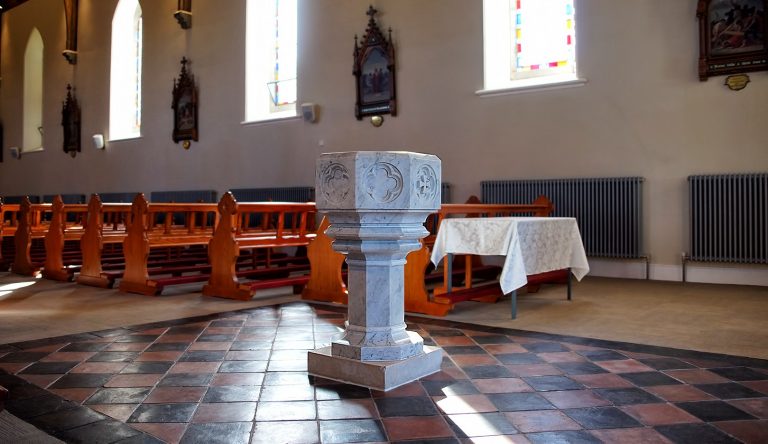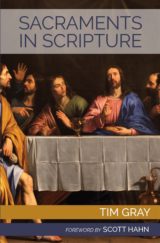By Tim Gray
Dr. Tim Gray is the President of the Augustine Institute, and Professor of Sacred Scripture at St. John Vianney Theological Seminary. He holds a PhD in Biblical Studies from Catholic University of America.

When we read the Bible, we easily notice all the great miracles and mighty deeds of the past, and wonder why God does not act in our lives. But that is where the sacraments and the liturgy come in. Christianity is not a “religion of the book,” in that we only read about what God did in the past; no, through the sacraments and liturgy God continues to make present His saving grace.
Thus the sacraments turn past history into present mystery. For example, God’s salvation of Israel from her bondage to Egypt through the waters of the Red Sea and the anointing of Jesus by the Holy Spirit in the Jordan become present for us in the Sacrament of Baptism. In Scripture we hear what God has done for His people before us, but through the sacraments we experience how these deeds are effective for us. The liturgy and sacraments are our doorway into the story of salvation. Thus the covenant drama is not simply the story of Israel, Jesus, the disciples, and others, but through our participation in the sacraments, beginning with Baptism, it is our own story.
This calls for a Catholic worldview, a new vision to see how the sacraments make present the power and life of Christ in our lives. “The catechetical message helps the Christian to locate himself in history and to insert himself into it, by showing that Christ is the ultimate meaning of this history” (General Directory for Catechesis 98). We see, then, that salvation history does not end with the death of the apostles, but continues in our day. Our lives are part of the story—our own story is a chapter in the life of Christ through all time. This is the mystery of the economy of salvation, that Jesus is prefigured in the Old Testament, made manifest in the New Testament, and “post-figured” by us living the life of Christ today. This is a profoundly spiritual vision that the sacraments invite us to live out. “But this also demands that catechesis help the faithful to open themselves to this spiritual understanding of the economy of salvation as the Church’s liturgy reveals it and enable us to live it” (CCC 1095).
The meaning of the sacraments flows from Scripture like water flows from a spring. What happens when a river is cut off from its source? Cut off the sacraments from Scripture, and the understanding and appreciation of the sacraments dry up. Too often the sacraments are taught without any reference to their relationship with Scripture, and thus many Catholics do not have a solid understanding of what the sacraments mean. For example, most Catholics have witnessed a baptism. But few understand how the water used in Baptism relates to the Old and New Testaments. Without this understanding, the faithful are unable to open themselves up to the meaning and mysteries of the sacraments (CCC 1095).
The sacraments effect grace by their very operation, which is the meaning of the Latin theological axiom, ex opere operato. “Nevertheless, the fruits of the sacraments also depend on the disposition of the one who receives them” (CCC 1128). How can one be fully disposed to receive the grace of the sacraments if there is no understanding of what the sacrament signifies? Without an adequate biblical formation, one could view the sacraments simply as Church rituals that somehow give grace—an understanding that leads many outside the Church to view the Catholic teaching on the sacraments as primitive ritualism or even magic.
A simple definition of a sacrament is that it is an outward sign that gives grace. As Saint Thomas Aquinas wrote, “Sacraments are visible signs of invisible things whereby man is made holy.”
A sacrament consists of two parts, matter and form. This philosophical terminology, taken up by Saint Thomas Aquinas from the Greek philosopher Aristotle, can seem a bit abstract to us, but is really quite simple. The matter relates to the physical elements of the sacrament, and the form to the words used. Both are essential. For example, Baptism consists of the matter, water, and the form, “I baptize you in the name of the Father, the Son, and Holy Spirit.” Both the water and the Trinitarian formula are required for the Sacrament of Baptism. Every sacrament has an outward sign (matter) accompanied by the words (form). Saint Augustine noted how the physical element and the word are the basis of a sacrament: “The word comes to the element and a sacrament results.”
You Might Also Like

Sacraments in Scripture: Salvation History Made Present is a Bible study on the seven sacraments, prefigured in the Old Testament and instituted by Jesus Christ in the New. Following the teaching of the Second Vatican Council and the Catechism of the Catholic Church on Sacred Scripture, Tim Gray delves into the biblical origin of each of these masterpieces of God’s love. In Sacraments in Scripture, Tim Gray guides readers through the Gospels, showing Christ’s deliberate acts that inaugurated these sacred signs as the foundation of the New Covenant.